MIST
Magnetosphere, Ionosphere and Solar-Terrestrial
Nuggets of MIST science, summarising recent papers from the UK MIST community in a bitesize format.
If you would like to submit a nugget, please fill in the following form: https://forms.gle/Pn3mL73kHLn4VEZ66 and we will arrange a slot for you in the schedule. Nuggets should be 100–300 words long and include a figure/animation. Please get in touch!
If you have any issues with the form, please contact This email address is being protected from spambots. You need JavaScript enabled to view it..
Current Density in Saturn’s Equatorial Current Sheet: Cassini Magnetometer Observations
by Carley J. Martin (Lancaster University)
Saturn’s rapidly rotating magnetosphere forms an equatorial current sheet that is prone to both periodic (i.e. flapping, breathing [see MIST nugget by Arianna Sorba]) and aperiodic movements (i.e. Martin & Arridge [2017]).
Although the current density of the sheet structure has been discussed by many previous authors, the current density in the middle to outer magnetosphere has not been fully explored. To this end we analysed aperiodic wave movements of Saturn’s current sheet, determined using Cassini’s magnetometer observations. The data were fitted to a deformed current sheet model in order to estimate the magnetic field value just outside of the current sheet, plus the scale height of the current sheet itself. These values were then used to calculate the height integrated current density.
We find a local time asymmetry in the current density, similar to the relationship seen at Jupiter, with a peak in current density of 0.04 A/m at ~ 3 SLT (Saturn Local Time). We then used the divergence of the azimuthal and radial current densities to infer the field-aligned currents that flow out from the equator pre-noon and enter the equator pre-midnight, similar to the Region-2 current at Earth. This current closure could enhance auroral emission in the pre-midnight sector by up to 11 kR.
Overall, the results provide important information into the asymmetries of the current sheet, and the characteristics of the current sheet suggest important field-aligned current systems that shape Saturn’s auroral emissions.
For more information, please see the paper below:
Martin, C. J., & Arridge, C. S. (2019). Current density in Saturn's equatorial current sheet: Cassini magnetometer observations. Journal Geophysical Researcher: Space Physics, 124, 279–292. https://doi.org/10.1029/2018JA025970
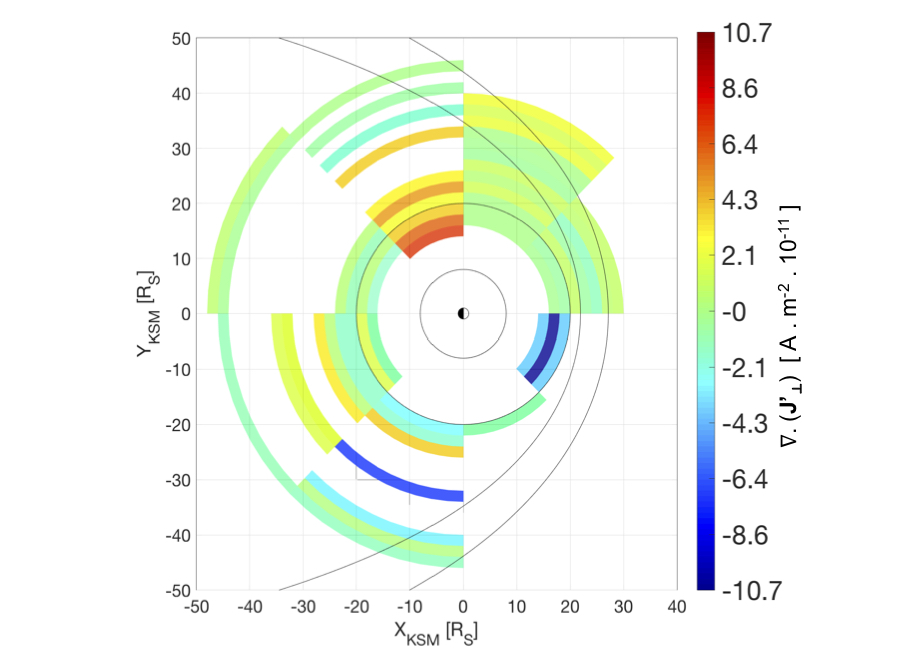
Figure: Divergence of height-integrated perpendicular current density (which infers the field-aligned current density). The coloured blocks show the average value of the divergence projected onto the X-Y plane in KSM (Kronocentric Solar Magnetospheric) coordinates. A range of magnetopause positions is shown using Arridge et at. (2006) along with the orbits of Titan (20 RS) and Rhea (9 RS), all shown in grey.
Observations of magnetic reconnection in Earth’s bow shock
by Imogen Gingell (Imperial College London)
The bow shock is a thin transition between super-sonic solar wind flows and sub-sonic flows in the Earth’s magnetosheath, during which the plasma is rapidly compressed and heated. In space plasmas, particle collisions cannot provide sufficient energy dissipation to slow the flow to sub-sonic speeds. Instead, nonlinear, electromagnetic plasma processes must be responsible.
Recent simulations (hybrid and fully kinetic particle-in-cell) have shown that current sheets and magnetic islands may be generated within the bow shock’s thin transition region (see Gingell et al 2017). This implies that magnetic reconnection, i.e. a localised change in the topology of the magnetic field, may be among the nonlinear processes responsible for heating in the shock transition layer. However, reconnection is not currently included in shock models.
Using data provided by NASA’s Magnetospheric Multiscale mission (MMS), we have now detected signatures of reconnection occurring at current sheets embedded in the shock. These signatures include a reversal of the magnetic field direction over ion inertial scales and a coincident super-Alfvénic jet of electrons corresponding the outflow from the reconnection site (see Fig 1). The increase in the electron temperature is consistent with previous observations of reconnection at the magnetopause. However, the lack of an ion jet or heating is similar to recent observations within the magnetosheath.
Now that we have confirmed that reconnection can occur within the bow shock, we must assess the broader impact of reconnection on heating and particle acceleration at shocks, explore the evolution of reconnecting structures as they convect downstream, and determine the parameter regime over which shock reconnection can occur.
For more information, please see the paper below:
Gingell, I., Schwartz, S. J., Eastwood, J. P., Burch, J. L., Ergun, R. E., Fuselier, S., et al. (2019). Observations of magnetic reconnection in the transition region of quasi‐parallel shocks. Geophysical Research Letters, 46. https://doi.org/10.1029/2018GL081804
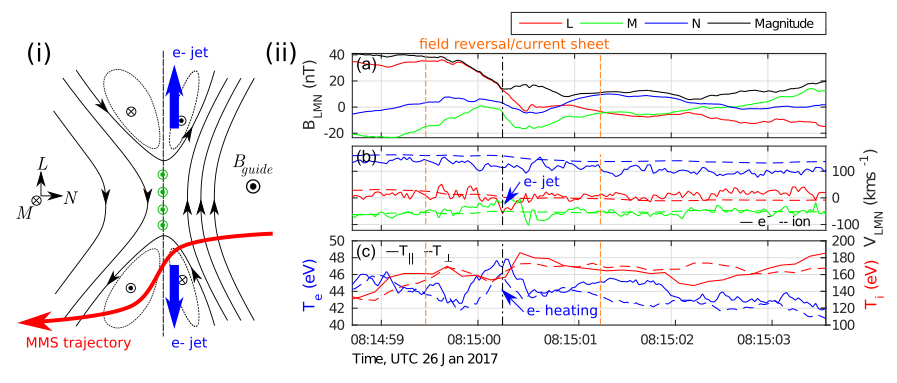
Fig 1. (i) schematic of the structure of a reconnecting current sheet, showing magnetic field (black), current density (green), electron outflow jets (blue) and spacecraft trajectory for the observed event (red). (ii) observations of a current sheet in the bow shock, showing (a) magnetic field, (b) electron and ion bulk velocities, and (c) electron ion temperatures.
The surprisingly variable current system inside Saturn’s D ring
by Gabby Provan & Stan Cowley (University of Leicester)
During Cassini’s Grand Finale, the spacecraft made 22 daring “proximal” periapsis passes between the denser layers of Saturn’s upper atmosphere and the inner edge of the planet’s innermost D ring (Figure 1a). This region had never previously been explored. On every pass Cassini’s magnetometer observed unanticipated perturbations in the azimuthal magnetic field component, confined to field lines that pass through and inside of the D ring in the equatorial plane, peaking typically at a few tens of nano-Tesla. Since the fields are near-symmetric about the magnetic equator, they are consistent with interhemispheric currents flowing along the near-equatorial magnetic field lines, as illustrated in Figure 1b.
Here we examine the azimuthal field perturbations on all the proximal passes, and show that they are surprisingly variable in form and magnitude. While a third of the passes indicate a unidirectional current flow, and a further third shows multiple sheets of oppositely-directed currents. The remaining passes present diverse signatures, including two passes showing reverse currents, and two with only small and fluctuating perturbations. This variability is not related to the spacecraft trajectory or organized by any known rotational period of the Saturnian system (i.e. the phase of the Saturn’s planetary period oscillations or the rotational phase of the D68 ringlet).
Khurana et al. (2018) suggested that these currents are generated by differential zonal thermospheric wind drag acting in the ionosphere at the two ends of these inner field lines. If so, these results show that either Saturn’s ionospheric zonal winds or ionospheric conductivity, or both, are very variable over the ~6.5 day orbital period of these periapsis passes. Our results add to the body of evidence showing that there is a significant and variable dynamical interaction between the material in Saturn’s D ring and the planet’s equatorial atmosphere.
For more information, please see the paper below:
Provan, G., Cowley, S. W. H., Bunce, E. J., Bradley, T. J., Hunt, G. J., Cao, H., & Dougherty, M. K. (2019). Variability of intra–D ring azimuthal magnetic field profiles observed on Cassini's proximal periapsis passes. Journal of Geophysical Research: Space Physics, 124. https://doi.org/10.1029/2018JA026121
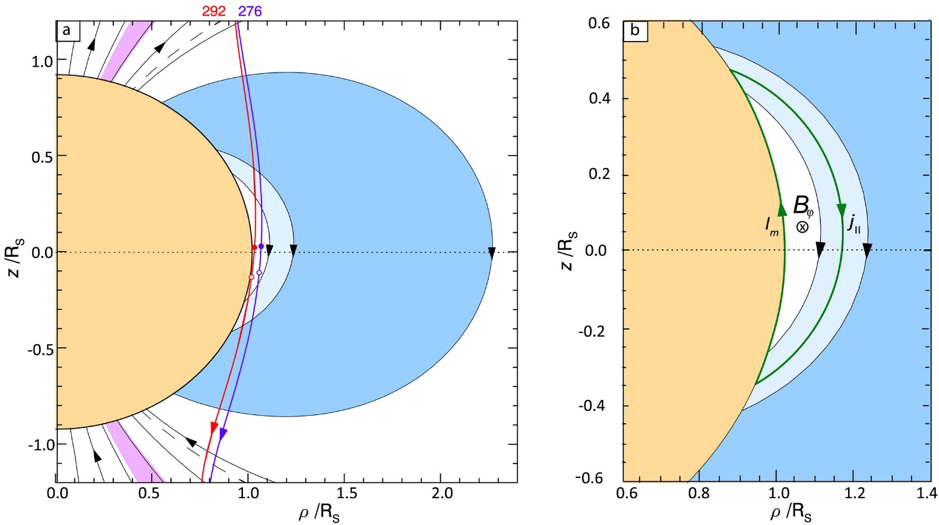
Figure 1: (a) The spacecraft trajectory of two example proximal passes. The planet is shown in orange, and the arrowed black lines show model magnetic field lines. The A to C rings are shown in dark blue, and the D ring in lighter blue. The suggested intra-D ring current system is shown in green in panel (b).
Field line resonance in the Hermean magnetosphere: structure and implications for plasma distribution
by Matthew K. James (University of Leicester)
Mercury’s magnetosphere is the smallest and most active within our solar system, providing a unique laboratory for studying magnetospheric physics, where much can be ascertained using ultra low frequency (ULF) waves. ULF waves are a key mechanism in the transmission of energy, momentum and information around any magnetised plasma environment and have been observed in magnetospheres throughout the solar system (e.g. Mercury, Earth, Jupiter, Saturn and Ganymede). The frequencies and polarizations of a certain class of ULF waves, called magnetohydrodynamic shear Alfvén waves, can be used to diagnose the plasma mass loading within the magnetosphere. Shear Alfvén waves are transverse standing waves which exist on field lines bound at both ends to the planet in question, where the perturbed magnetic field is displaced azimuthally around the planetary magnetosphere. These waves are analogous to the waves standing on a guitar string, where only standing waves with discrete frequencies are supported. At Earth, these waves are often driven by solar wind forcing on the magnetosphere in a process known as field line resonance (FLR).
Until recently, it was thought that Mercury's magnetosphere was incapable of supporting such FLRs due to its relatively small size. Our study is the first statistical survey of FLRs in the Hermean magnetosphere; we used magnetic field observations from the spacecraft MESSENGER to detect 566 FLRs within the dayside of the magnetosphere. An example simulation of one such Hermean FLR is presented in the figure below, where the field oscillates with a combination of both the fundamental and second harmonic frequencies.The characteristics of these waves were used to determine plasma mass densities throughout the dayside magnetosphere. We also found that the structure of the resonant waves is highly asymmetric about the magnetic equator, with the largest field perturbations appearing north of the magnetic equator due to the offset of the magnetic dipole into the northern hemisphere of the planet.
For more information, please see the paper below:
James, M. K., Imber, S. M., Yeoman, T. K., & Bunce, E. J. (2019). Field line resonance in the Hermean magnetosphere: Structure and implications for plasma distribution. Journal of Geophysical Research: Space Physics, 124. https://doi.org/10.1029/2018JA025920
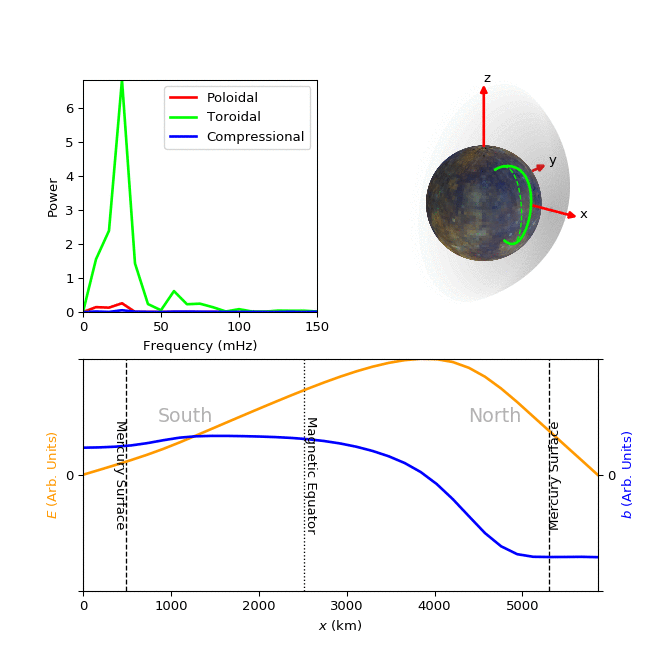
Figure: Top left panel shows the power spectrum of the poloidal (red), toroidal (green) and compressional (blue) components of a FLR detected using MESSENGER. The majority of the wave power is seen in the toroidal component at 25 mHz (fundamental frequency), some toroidal wave power is also present at 60 mHz (second harmonic). The top right panel is an animation showing how the displacement of the field line (solid green line) might vary with time, compared to the unperturbed field (dashed green line), as it oscillates with a combination of the two detected frequencies at the location of this resonance. The bottom panel contains an animation showing how the electric (yellow) and magnetic perturbation (blue) fields would vary in time along the length of the field line, x.
Measuring a geomagnetic storm with a Raspberry Pi magnetometer
by Ciarán Beggan (British Geological Survey)
As computers such as the Raspberry Pi and geophysical sensors have become smaller and cheaper it is now possible to build a reasonably sensitive system which can detect and record the changes of the magnetic field caused by the Northern Lights (aurora). Though not as accurate as a scientific level instrument, the Raspberry Pi magnetometer costs around 1/100th the price (about £180 at 2019 prices) for around 1/100th the accuracy (~1.5 nanoTesla). However, this is sufficient to make interesting scientific measurements.
During 2017, a network of 9 Raspberry Pi magnetometers were deployed to schools around the UK from Benbecula to Norwich. On the 8th September 2017 a large geomagnetic storm was captured by the school magnetometers. Using these data and the array of other magnetometers around the North Sea, we were able to recreate the spatial and temporal changes of the magnetic field during the storm in great detail. The two phases of the storm (see Figure) show the westward (night time) and eastward (daytime) flow of the auroral electrojet currents in the ionosphere.
The results are given in more detail in our paper, but we have shown that it is possible to augment the existing professional network with citizen science sensors to fill in the ‘gaps’ for large geomagnetic storms.
Please see the paper below for more information:
Beggan, C. D. and Marple, S. R. (2018), Building a Raspberry Pi school magnetometer network in the UK, Geosci. Commun., 1, 25-34, https://doi.org/10.5194/gc-1-25-2018
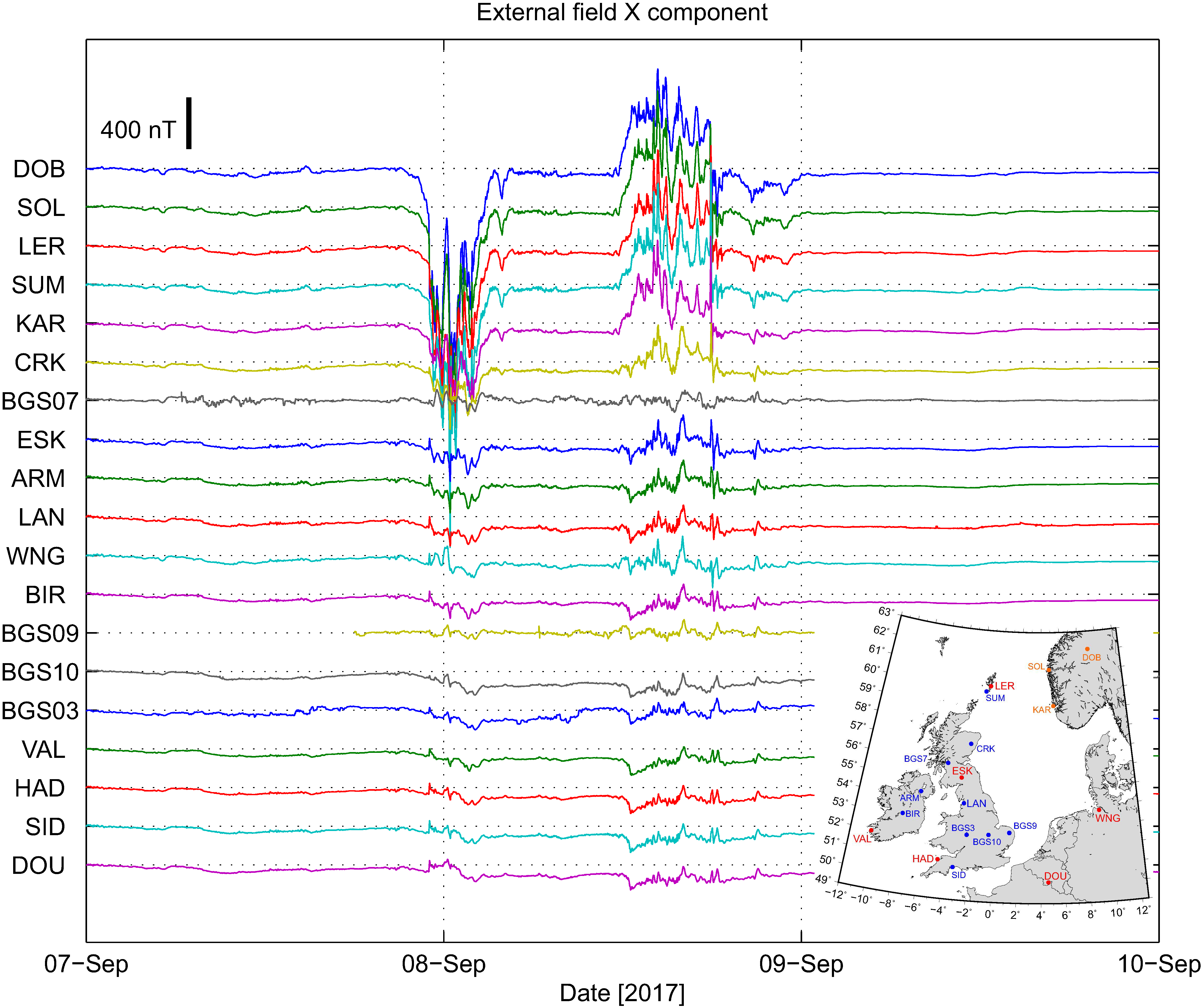
Figure: Stackplot of the variation of the magnetic North component of the magnetic field for the geomagnetic storm of the 7-8th September 2017, ordered by latitude. Inset: Map of the locations of the variometers and observatories around the North Sea.